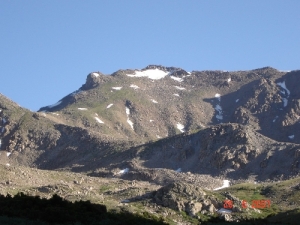Trip Report 3
- Points Earned: 1
- Trip Dates: August, 1987?
- Wilderness Area: Collegiate Peaks
- Wilderness Size: 167,414 acres
- Location: Central Colorado
- Destination: Summits of Mount Harvard and Mount Columbia
- Total Miles: 13.5
- Duration: Day Hike

Summit of Mount Harvard

Summit of Columbia from the ridge between Columbia and Harvard
My experience climbing Harvard and Columbia (two Colorado “fourteeners”) together was a lesson in why it may not be a good idea to separate from your hiking party. I also remember it as a beautiful and interesting trip.
After a long valley approach, we finally reached the summit of Harvard, Colorado’s 3rd highest mountain at 14,420 feet. A persistent marmot made a residence right at the very top of the mountain. I shared some of my sandwich with him (which I now know is not good for the marmot as it reinforces its dependence on people for food. But, I figure enough people climb Mt. Harvard that his eventual demise was not caused by starvation).
Harvard and Columbia are connected by a high ridge making for a long, but very doable, double summit in a single day. Often times in Colorado gathering storms force you down from the tundra by early afternoon. But, at lunch time on the summit of Harvard the sky was still virtually cloudless giving us at least 2-4 more hours of safe above-timberline travel.
From the summit of Harvard there are two options to reach Columbia. You can take the easier, safer, but longer route that dips a few hundred feet below the ridge-line and then ascend the wide open slope of Columbia to the summit. Or, you can stay high on the ridge-line, which is shorter, but more difficult, and potentially more dangerous, requiring some scrambling.
I was a teenager at the time hiking with my mother and her good friend. I felt more adventurous than they did and convinced them that it would be okay for me to take the high route while they took the low, and meet up at the summit of Columbia (14,077 feet)
The ridgeline was interesting and fun requiring some scrambling along ledges and up and over small rock shelves and boulders. But, when I reached the summit of Columbia, I looked down to where I thought my companions would be climbing up from and didn’t see anyone. I waited for a few minutes and looked again… still no one. I began to worry. I waited a half-hour and by then another party of two had arrived on the summit, and it was now half-past four in the afternoon. Fortunately, the weather was holding, but I still saw no one coming up the mountainside from below.
I looked at the map and decided that one of them was either injured or too tired to make it, so they decided to head down the French Valley away from the summit instead of climbing up and over Mount Columbia. This greatly concerned me. I have always been good at reading maps, even as a kid. On my map I could tell that the French Valley was a very long hike to the nearest road–several miles farther in fact than the planned route back to the trailhead over the top of Columbia. I became convinced that this was what happened. So, I decided to descend the mountain with the other party. ( I believe I recall attempting to leave a note on the summit register just in case, but can’t be sure–it was over 20 years ago).
I hiked back, worried, with the other party and finally reached the trailhead at near 7:00. I stayed at the car at the trailhead and asked the two men to notify the sherrif in Beuna Vista of two hikers that would likely be trying to hike out of the French Valley after dark.
Low and behold, about an hour later, here comes my mom and her friend down the trail, right at dusk. They had, indeed, hiked to the summit of Columbia afterall! Why I could never spot them, I can only guess was because the distances involved were greater than they seemed high up on those mountains. I was probably looking right at them, but could not see them as they would have looked like tiny specs perhaps periodically hidden behind the boulders of Columbia’s flanks.
As we drove out of the access road towards the Arkansas Valley, the forest ranger truck approached in the other direction, flashing it’s lights. “We have a report of two lost hikers in this area, do you have any info that could help us?”
It was a little embarrassing, but the ranger was relieved not to have to mount a search operation. He agreed that, had they decided to hike out through French Valley, it would have been a very long and dark trip well into the night. Not long after passing the ranger, a substantial and persistent rainstorm enveloped the entire region. It would have been a long, cold and uncomfortable night indeed.
This was a lesson I will always remember. Things that seem so simple can often become worrisome or even dangerous situations in the wilderness. You always have to think about the potential hazards of wilderness travel and mitigate risks, even if they seem trivial.
The pictures used for this post were found on the internet.
Read Full Post »


